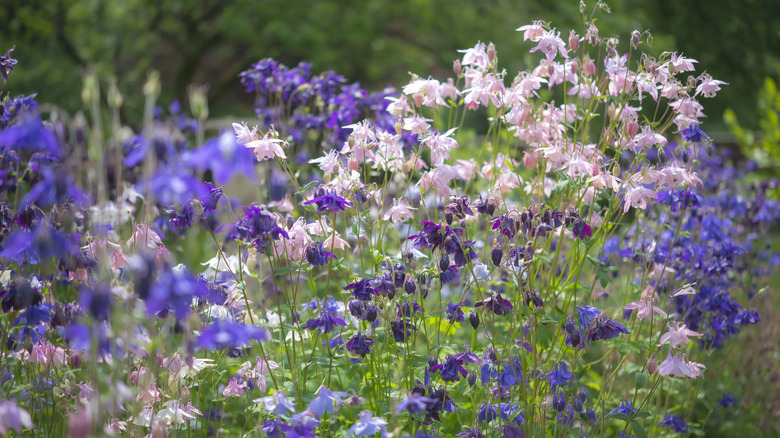Here Are The Perfect Conditions To Grow Columbine Plants For Beautiful Blooms
Columbines (Aquilegia canadensis) are a beautiful and reliable spring bloomer, offering delicate flowers that come in practically every color of the rainbow. The flowers last for weeks from mid to late spring and the foliage is sprightly and attractive through the summer. Columbines go to seed in late summer, so before deadheading the blooms, collect some seeds for replanting. They're not too fussy, but they do need the right soil and light conditions to thrive. Well-drained soil and partial or dappled sunlight provide the perfect growing environment for these hardy perennial flowers.
Columbines are hardy in USDA zones 3 to 9, and will grow well in full sun in regions that have cooler summers. However, hot summer temperatures and even unseasonably warm spring temperatures may cause the flowers to wilt a bit, which can shorten the blooming season. Additionally, bright summer sunlight later in the season can scorch the leaves. So planting columbines in a location where they will not get too much bright afternoon sun is best.
You can sow columbines from seed in spring or fall. They will also reseed readily in the garden, sometimes creating new hybrid color combinations from existing plants. If your seedlings come up in a place that's not ideal, you can carefully relocate them, or wait a year until the root is a bit more developed to dig up. Columbine seedlings will usually start flowering after two years. The plants are easier to divide once the root clumps have reached a fairly substantial size (at least 8 inches in diameter), so that there are multiple roots that can be gently pulled or cut apart.
Soil and moisture considerations for beautiful columbine blooms
In addition to considering the sunlight conditions for growing columbines, you should also make sure they have appropriate soil conditions. These flowers prefer a well-drained soil environment. If the growing spot is too boggy or wet, this can lead to root rot, so you want a location that has good drainage. If your garden has heavy clay soil, adding some soil amendments (such as peat moss, composted manure, or a soil-compost mix) to improve the texture and drainage will benefit your columbines.
If transplanting columbines, dig a deep hole and add some well-draining soil to give them a good start. However, columbines do not require an especially rich soil, so don't use a soil with fertilizer added. If transplanting in the fall, give them a light layer of natural mulch (such as pine bark) to protect the roots during the winter. Columbines survive winter temperatures well once they're established, but smaller seedlings would benefit from some protection, so give them some mulch, also.
Over time, you may find you have a patch of columbines that have reseeded in the same area. It's recommended you plant columbines 1 to 2 feet apart, so if seedlings get overcrowded, thin them out as needed. This will keep them looking vibrant and let them get good air circulation and soil nutrition. Given the right growing conditions, columbines can live up to five years or more, though on average the plants last two to four years.

